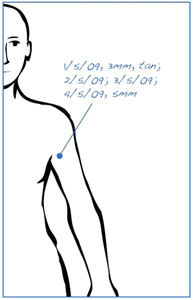Early Detection and Self Exams

The Skin Cancer Foundation recommends that everyone practice monthly head-to-toe self examination of their skin, so that they can find any new or changing lesions that might be cancerous or precancerous. Skin cancers found and removed early are almost always curable. Learn about the warnings signs of skin cancer and what to look for during a self examination. If you spot anything suspicious, see a doctor.
Performed regularly, self-examination can alert you to changes in your skin and aid in the early detection of skin cancer. It should be done often enough to become a habit, but not so often as to feel like a bother. For most people, once a month is ideal, but ask your doctor if you should do more frequent checks.
You may find it helpful to have a doctor do a full-body exam first, to assure you that any existing spots, freckles, or moles are normal or treat any that may not be. After the first few times, self-examination should take no more than 10 minutes – a small investment in what could be a life-saving procedure.

If You Can Spot It, You Can Stop It
Skin cancer is the most common of all cancers, afflicting more than two million Americans each year, a number that is rising rapidly. It is also the easiest to cure, if diagnosed and treated early. When allowed to progress, however, skin cancer can result in disfigurement and even death.

Step by Step Self Exam
Skin cancer is the most common of all cancers, afflicting more than two million Americans each year, a number that is rising rapidly. It is also the easiest to cure, if diagnosed and treated early. When allowed to progress, however, skin cancer can result in disfigurement and even death.

Make the Most of Your Appointment
A visit to the dermatologist should be enlightening, but if you're not prepared it can leave you in the dark. To help you make the most of your appointment, The Skin Cancer Foundation asked Elizabeth Tanzi, MD, for advice on what to expect during a routine full-body skin examination.
Download our printable Body Map and Self-Examination Schedule to keep track of any spots that you notice on your body. On the first self exam, make a dot corresponding to the location on your skin of each freckle, mole, birthmark, bump, sore, scab, or scaly patch. Draw a line out to the margin and indicate its approximate size and color, and the date. For each exam after that, find the spot on your skin that matches each dot, record the new date next to the old one, and note any change in size, color, or shape. Record any spots you did not see on last examination. Use the Self-Examination Schedule to keep track of the dates on which you examined yourself. Indicate year, month, and day.
During Self Exams, Use a Body Map


